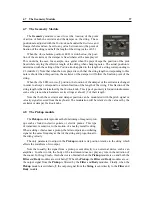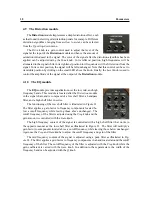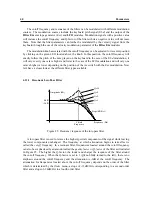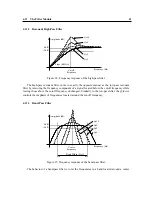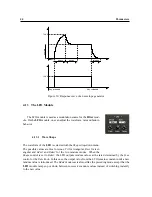
4.18
The Output Effect Section
51
The Delay drop down menu is used to choose between different delay algorithms. The effect
can be synchronized to the Clock module with the Sync drop-down menu. Sync values range from
1/8 of a quarter note (a thirty-second note) to 16 quarter notes (4 whole notes) where the duration
of the whole note is determined by the value (in BPM) appearing in the Tempo display of the Clock
module. The effect can also be synced to a triplet (t) or dotted note (d).
The different delay algorithms can be controlled with the three knobs appearing at the bottom
of the module. The Mix knob is used to adjust the ratio of “dry” and “wet” in the output signal of
the module. When the knob is adjusted in the left position, only the original or “dry” signal is sent
to the output while in the right position only the processed or “wet” signal is sent to the output. In
its center position there is equal amounts of “dry” and “wet” signal in the output signal. The Depth
knob is used to adjust the amount of signal re-injected from the output of a line into the other one
while the Rate knob controls the length of the delay lines and therefore the delay between echoes.
4.18.4
The Reverb module
The Reverb module is used to recreate the effect of reflections of sound on the walls of a room or
hall. These reflections add space to the sound and make it warmer, deeper, as well as more realistic
since we always listen to instruments in a room and thus with a room effect.
The Reverb drop down menu is used to choose between different reverb algorithms representing
different types of rooms or halls. Each algorithm can be adjusted with the knobs located at the
bottom of the module. The Mix knob is used to set the relative amount of “dry” and “wet” signal
which is related to the proximity of the sound source. The Decay is used to control the reverberation
time of the room. In a real room, the reverberation time is not constant across the whole frequency
range because the walls of the hall are generally more absorbent at high frequencies which results
in a shorter reverberation time for these frequencies. This effect is controlled with the Color knob
which sets the reverberation time of high frequencies relatively to the value of the Decay knob.
Note that the settings of the different modules of the output stage are saved with presets. In
order for the effects to remain with the same settings even when loading new presets, click on the
Lock icon at the top of the module.
4.18.5
Topology
The three effects of the output section can be used in four different configurations as shown in
Figure 32 and where the Chorus, Delay and Reverb modules are labeled A, B, and C respectively.
Figure 32: The four topologies in which the effects can be applied after the Amp module of the
two module rows; A
=
Chorus module, B
=
Delay module and C
=
Reverb module.
Summary of Contents for STRINGSTUDIO
Page 1: ...USER MANUAL ...

